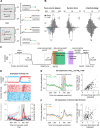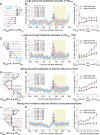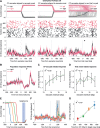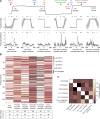Cerebellar complex spikes multiplex complementary behavioral information
- PMID: 34529650
- PMCID: PMC8478165
- DOI: 10.1371/journal.pbio.3001400
Cerebellar complex spikes multiplex complementary behavioral information
Abstract
Purkinje cell (PC) discharge, the only output of cerebellar cortex, involves 2 types of action potentials, high-frequency simple spikes (SSs) and low-frequency complex spikes (CSs). While there is consensus that SSs convey information needed to optimize movement kinematics, the function of CSs, determined by the PC's climbing fiber input, remains controversial. While initially thought to be specialized in reporting information on motor error for the subsequent amendment of behavior, CSs seem to contribute to other aspects of motor behavior as well. When faced with the bewildering diversity of findings and views unraveled by highly specific tasks, one may wonder if there is just one true function with all the other attributions wrong? Or is the diversity of findings a reflection of distinct pools of PCs, each processing specific streams of information conveyed by climbing fibers? With these questions in mind, we recorded CSs from the monkey oculomotor vermis deploying a repetitive saccade task that entailed sizable motor errors as well as small amplitude saccades, correcting them. We demonstrate that, in addition to carrying error-related information, CSs carry information on the metrics of both primary and small corrective saccades in a time-specific manner, with changes in CS firing probability coupled with changes in CS duration. Furthermore, we also found CS activity that seemed to predict the upcoming events. Hence PCs receive a multiplexed climbing fiber input that merges complementary streams of information on the behavior, separable by the recipient PC because they are staggered in time.
Conflict of interest statement
The authors have declared that no competing interests exist.
Figures








Similar articles
-
Climbing fibers predict movement kinematics and performance errors.J Neurophysiol. 2017 Sep 1;118(3):1888-1902. doi: 10.1152/jn.00266.2017. Epub 2017 Jul 12. J Neurophysiol. 2017. PMID: 28701537 Free PMC article.
-
Climbing Fibers Control Purkinje Cell Representations of Behavior.J Neurosci. 2017 Feb 22;37(8):1997-2009. doi: 10.1523/JNEUROSCI.3163-16.2017. Epub 2017 Jan 11. J Neurosci. 2017. PMID: 28077726 Free PMC article.
-
Dynamic modulation of mossy fiber system throughput by inferior olive synchrony: a multielectrode study of cerebellar cortex activated by motor cortex.J Neurophysiol. 2001 Nov;86(5):2489-504. doi: 10.1152/jn.2001.86.5.2489. J Neurophysiol. 2001. PMID: 11698537
-
Climbing fibers mediate vestibular modulation of both "complex" and "simple spikes" in Purkinje cells.Cerebellum. 2015 Oct;14(5):597-612. doi: 10.1007/s12311-015-0725-1. Cerebellum. 2015. PMID: 26424151 Review.
-
Cerebellar control of saccadic eye movements: its neural mechanisms and pathways.Jpn J Physiol. 1991;41(3):351-68. doi: 10.2170/jjphysiol.41.351. Jpn J Physiol. 1991. PMID: 1960885 Review.
Cited by
-
Cerebellar climbing fibers multiplex movement and reward signals during a voluntary movement task in mice.Commun Biol. 2023 Sep 9;6(1):924. doi: 10.1038/s42003-023-05309-9. Commun Biol. 2023. PMID: 37689776 Free PMC article.
-
A triple distinction of cerebellar function for oculomotor learning and fatigue compensation.PLoS Comput Biol. 2023 Aug 4;19(8):e1011322. doi: 10.1371/journal.pcbi.1011322. eCollection 2023 Aug. PLoS Comput Biol. 2023. PMID: 37540726 Free PMC article.
-
Multidimensional cerebellar computations for flexible kinematic control of movements.Nat Commun. 2023 May 3;14(1):2548. doi: 10.1038/s41467-023-37981-0. Nat Commun. 2023. PMID: 37137897 Free PMC article.
-
Excitatory nucleo-olivary pathway shapes cerebellar outputs for motor control.Nat Neurosci. 2023 Aug;26(8):1394-1406. doi: 10.1038/s41593-023-01387-4. Epub 2023 Jul 20. Nat Neurosci. 2023. PMID: 37474638 Free PMC article.
-
Complex spikes perturb movements and reveal the sensorimotor map of Purkinje cells.Curr Biol. 2023 Nov 20;33(22):4869-4879.e3. doi: 10.1016/j.cub.2023.09.062. Epub 2023 Oct 18. Curr Biol. 2023. PMID: 37858343 Free PMC article.
References
-
- Albus JS. A theory of cerebellar function. Math Biosci. 1971;10(1–2):25–61.
Publication types
MeSH terms
Associated data
LinkOut - more resources
Full Text Sources

